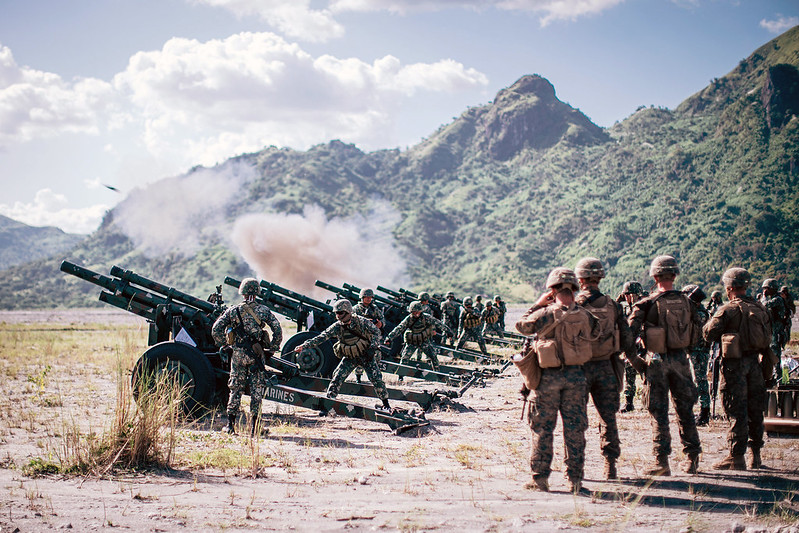
Long waits can let cooler heads prevail and reverse hot-headed decisions.
In January, President Rodrigo Duterte of the Philippines threatened to terminate the 1998 Philippine–US Visiting Forces Agreement—a treaty-level pact that provides the operational framework for the alliance between the two countries—unless the White House reversed the cancellation of Philippine Senator Ronald dela Rosa’s visitor visa. Dela Rosa is a close confidant of Duterte and the chief architect of his signature ‘war on drugs’.
On 11 February, the Philippine government informed the US embassy in Manila that it planned to withdraw from the VFA. That move triggered the agreement’s 180-day cooling off period before termination.
Fifteen weeks later, on 1 June, the Philippine government sent a letter to the US embassy in Manila freezing the countdown to termination until at least 1 December 2020. Fortunately, the 1951 Mutual Defense Treaty and 2014 Enhanced Defense Cooperation Agreement between the two countries offer even longer periods for reconsideration. Both stipulate a one-year cooling off period in their termination clauses.
The 1 June temporary suspension came about despite the US side disappointing Duterte over his friend’s cancelled visa. The VFA, and by extension the US–Philippine alliance, will be safer from 1 December onwards if Duterte is disappointed again. He could be stripped of his power of termination. On 9 March, a majority of senators filed a petition with the country’s supreme court arguing that concurrence of the senate is required for terminating the VFA. The court has yet to hear this petition. If the court rules in favour of the senators, the VFA may well be taken off its suspended death clock.
It’s hard to envision a majority of senators supporting termination of the agreement, particularly given the depth of Philippine public opinion in favour of the US and against China. Duterte cannot run for re-election in 2022. Despite a super-majority of senators being aligned with the president, the Senate hasn’t done as he would wish before. Unlike the more pliant House of Representatives, the Senate has repeatedly blocked the president’s push for a federalist constitution and for reinstating the death penalty.
The supreme court, belying criticisms of being beholden to the president, also has issued rulings not favoured by the executive. In April 2019, it ruled against the solicitor-general and ordered the release of police files on thousands of alleged victims of the war on drugs.
It’s unlikely that US President Donald Trump’s administration or its successor will strengthen Manila’s support for the VFA by addressing a deeper Philippine disappointment with the alliance. The 2012 loss of control of Scarborough Shoal within the Philippine exclusive economic zone to China, and Beijing’s subsequent building of an artificial island and military base on the Philippine continental shelf at Mischief Reef, undercut the Philippine government’s belief in the bilateral alliance.
Secretary of National Defense Delfin Lorenzana expressed this alliance angst at his 2018 end-of-year press conference when he called for a review of the 1951 Mutual Defense Treaty and pondered its possible cancellation. Manila wants a clearer and broader US commitment to support the Philippines in its territorial and maritime rights disputes with China in the South China Sea. It’s not clear what the Philippines is willing to offer the US in return, beyond not threatening to walk away from the alliance. Eighteen months on from Lorenzana’s call for a review, none has been announced.
The fate of the VFA and the US–Philippine alliance matters to Australia, the only other country with a status-of-forces agreement with the Philippines. Australia’s defence relationship with the Philippines works best when US–Philippine defence relations are strong. In 2017, Australia, under its agreement with the Philippines, provided vital aid to the country’s armed forces during the terrorist siege of Marawi City. Australian support complemented the much greater support provided by American forces under the VFA that no other country could have provided. Japan is currently negotiating a status-of-forces agreement with the Philippines; termination of the VFA could certainly dampen Tokyo’s interest.
Duterte’s disappointments with the US and the bilateral alliance were behind his January threats and his February decision to withdraw from the VFA. Disappointing Duterte again with a supreme court ruling in favour of the Senate may be the best way to ensure that the temporary suspension is transformed into a reversal of this ill-considered decision. Cooler heads then will have prevailed to the benefit of the Philippines, the US, Australia, Japan and Southeast Asia.
The author spoke at ASPI’s webinar on 16 June on the changing nature of Philippines–US defence relations, along with ASPI senior analyst Huong Le Thu; Jingdong Yuan, associate professor at the University of Sydney; John Powers, executive director of Intel Dynamics; and John Coyne, head of ASPI’s Strategic Policing and Law Enforcement and the North and Australia’s Security programs.
[Malcolm Cook is a visiting senior fellow at the ISEAS-Yusof Ishak Institute in Singapore. Image: US Indo-Pacific Command/Flickr.]

No comments:
Post a Comment
Note: Only a member of this blog may post a comment.